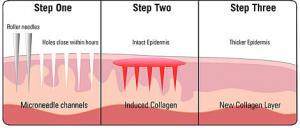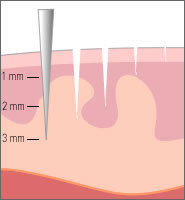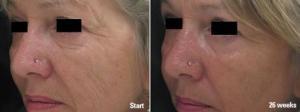- Track your orders
- Save your details for express checkout
- Join our loyalty points scheme and receive points and future discounts with every purchase
Information |
Training |
Media |
FAQs |
Enquiries |
Products |
  |
Biography: Canadian Skin treatment specialist Dr Lance Setterfield is researching the effects of dermal rolling of the epidermis (cosmetic needling) and dermis (medical needling) combined with pharmaceutical and homeopathic medications, plant extracts, vitamins, and other ingredients. The goal of the research is to narrow down the variables (e.g. depth of needles, frequency of treatment, topical ingredients and timing of their application, natural hindrances, synergistic modalities and timing of use) to facilitate optimum results. Dr Setterfield is the Medical Director of Acacia Dermacare |
Background:
Skin health is influenced by numerous factors including lifestyle, environment, genetics, hormones, nutrition etc. Aging results in poor absorption of ingested skin nutrients and poor delivery to the target secondary to vascular and lymph insufficiency. Topical application of nutrients is a logical solution, but the natural barrier created by the skin has always limited success.
Nanotechnology increases penetration, but the effects of the "vehicle” in the system are controversial. Enlarging the pathways through the skin with cosmetic needling to allow up to 80 percent more nutrients to penetrate has proven to be safe and effective. It is possible to obtain significant improvement of hyperpigmentation, fine lines and wrinkles, scarring, hair restoration and even UV spots over time. Some desire faster results, which lead to the next step up in treatment.
The majority of modalities used for skin rejuvenation incorporate the wound healing process. Conventional wisdom has leaned towards "more is best”. The biggest challenge is finding the balance between the degrees of injury (acceptable downtime) and effectiveness (best outcome). Darker skin types limit aggressive treatments. Ablative treatments, e.g. laser resurfacing and deep peeling, while aesthetically effective, may cause epidermal thinning, papillary dermis fibrosis and cicatricial healing. Fractional treatments minimize this effect, but there is still up to 20% coagulation of tissue and the ensuing necrosis stimulates cicatricial healing. Medical needling does exactly the opposite, which is ideal.
|
Preservation of the epidermis maintains environmental protection and minimizes downtime. There are no reported post treatment pigmentation issues, even with sun exposure. The procedure breaks down scar tissue, allowing reorganization. It can be performed on most areas of the body by individuals with minimal skills and requires minimal capital outlay. |
 |
Percutaneous collagen induction uses thousands of tiny needle pricks into the upper dermis to trigger the wound healing cascade. The upregulation of TGF-B3 through this process is thought to be the reason for natural collagen regeneration following needling, as opposed to scar collagen secondary to TGF-B1 and B2 associated with thermal injury.
Understanding the predictable phases of wound healing dictates optimum timing for treatment and modalities to obtain greatest success. Prolonging the inflammatory phase (day 1-5) will result in more growth factors. Photomodulation and lymph drainage are valuable from day 2-14 and then cosmetic rolling combined with Sonophoresis and micro-current are beneficial to assist maximum delivery of nutrients to cells. Collagenase peaks at around day 14 to reorganize collagen fibrils, converting collagen 3 to collagen 1 and it therefore makes no sense to reinjure the skin more frequently than every 30 days.
 |
Collagen synthesis requires Vitamin A (e.g. Retinyl Palmitate, Retinyl Acetate, Retinol or Tretinoin), Vitamin C (e.g. Magnesium Ascorbyl Phosphate, L-Ascorbic Acid), key amino acids (proline & glycine), bioflavonoids, growth factors, selenium, silicon allied with magnesium and calcium, copper peptides, zinc and iron (co-factors), hormones and essential fatty acids (for cell function and membranes). Stem cell products and platelet rich therapy hold enormous promise. |
Prominent South African surgeon Dr Des Fernandes pioneered much of the work on needling and in 1996 he used a 3 mm roller. Treatments were painful and required IV sedation and analgesia. Further studies by Dr Fernandes and Dr Aust in Germany concluded that similar results could be obtained using a 1 mm roller.
In 2008, Dr Greco authored an abstract and stated that biopsies revealed new collagen to a depth of 0.6 mm.
Even though 2.0 mm needles were used, no new collagen fibers could be found in the sub dermal layer illustrating no benefit to using longer more invasive needles. These findings could be extrapolated to fractional treatments to minimize injury.
Taking these findings a step further, is it possible that "less is best” in the context of cosmetic vs. medical rolling?
To gain some insight, a retrospective study on 44 patients was done using data from Visia Skin Analysis to provide "objective” numbers. While there are many variables (age, lifestyle, compliance, active ingredients and dose applied topically, duration of treatment etc.) the positive findings are encouraging in that they were obtained, for the most part, under least favorable conditions (compliance).
Methods: Measurements for brown spots, pores, wrinkles, evenness and UV spots were used to determine effectiveness of products alone vs. the use of rollers with 0.2 mm, 0.3 mm, 0.5 mm, 1 mm and 2 mm long needles combined with products.
Rolling frequency minimum of once a week (ideal once a day). Age range 29-68 yrs. (Avg. 49 yrs.) Vitamin A dose range 1500 IU to 50 000 IU. (Avg. 17 000 IU)
|
0.3mm for 6 months, products for 18 months. Patient 55 years old. Lapsed time between images 26 weeks (6 months) Conclusions: |
 |